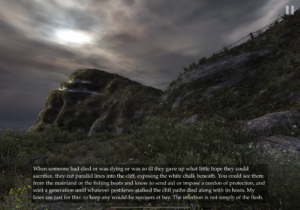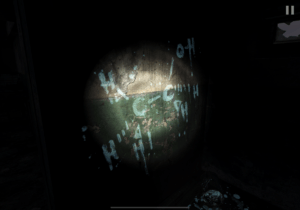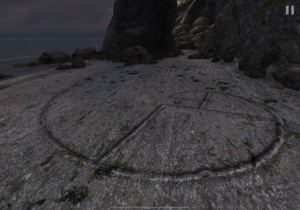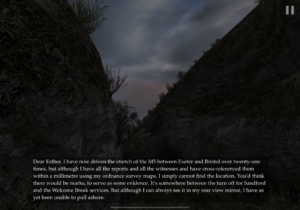This week, I played Dear Esther, created by The Chinese Room and developed by Distinctive Games/Sumo Digital Ltd for iOS, the platform I played on. It has an intended audience of mature people (not children, given its content) who enjoy stories rather than interaction.

Dear Esther is a single-player game, and the objective is focused on exploration/storytelling rather than competition or clear end-goals. The only actions the player has are moving/walking around and turning their view, and each chapter closes after the player gains the clues. It is similar to games such as Journey, What Remains of Edith Finch, and Firewatch because all are walking simulators centering exploration. However, Dear Esther is different because it is quite simplistic, even for a walking simulator; additionally, the story happened in the past and feels much more disconnected from the current period of exploration, compared to the other games that seem to focus the exploration/adventure in the present.

It intends to have fun through narrative, as well as perhaps discovery and sensation. It succeeds and uses walking to tell the story, where the player hears/sees narrations of letters and visual clues as they walk around; through walking/exploring, they gain more details that allow the story to unfold, as with an embedded narrative. The walking allows the dynamic of freedom and exploration which slowly contribute to the narrative aesthetic. Players explore the island to discover secrets, with the addition of detailed sensory cues throughout the exploration. For example, one of the narrations explained cutting parallel lines into the cliff and revealing white chalk underneath, which directly aligned with what the player currently saw.

However, the game might also “fail” in some ways, as it could be confusing to new players how to effectively navigate, and how the different pieces of the story connect. For instance, when I first played, I was confused about where I was supposed to go at times, and I even “died” after walking too far into the water as a result of not knowing where to go. I also do not completely understand how the different parts of the story connect, but perhaps this is addressed as the player progresses further and becomes more familiar with the story.


I would improve the game by trying to add more guardrails/hints for new users while minimizing disruption to the game flow. For instance, there could be an option to turn on “hints” that indicate where users can hear/explore more. This would change the mechanics and thus dynamics because the player would be able to get help if they needed it and be more confident, while not completely undermining the exploration goal. It might also be beneficial to create some sort of “timeline” or “backpack” to store the revealed clues so that users can review what they have learned without restarting entire levels. This would help strengthen the narrative aesthetic since players would be able to better keep track of the story as it unfolds.





